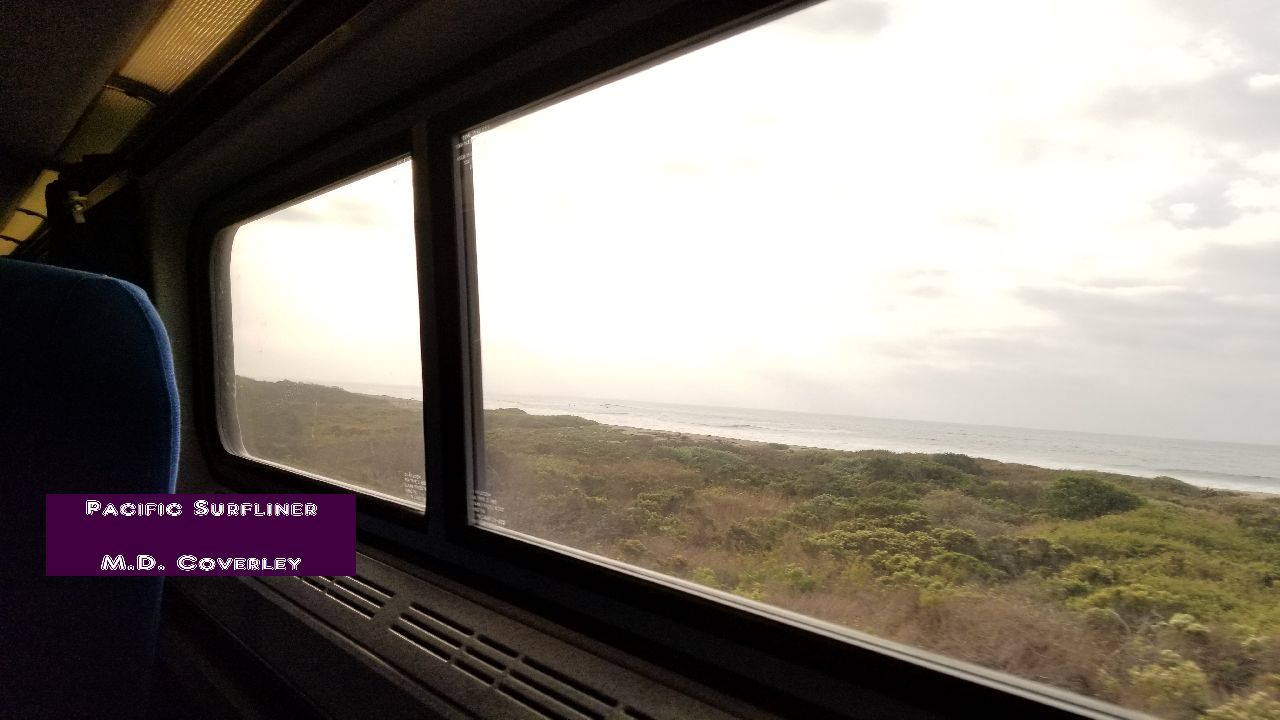Pacific Surfliner // San Juan Capistrano
M.D. Coverley

San Juan Capistrano
Pacific Surfliner // San Juan Capistrano M.D. Coverley |
||
 San Juan Capistrano |
| Background Music: "I Ride Alone" - George and Marguerite, Romantic Flamenco Guitar |
|
| Return to Pacific Surfliner Main Page |
The Pacific Surfliner is an Amtrak train serving the California coastline from San Luis Obispo to San Diego. Much of the line runs along some of the least-developed beaches in the southland.
Each stop might represent
a life – from San Juan Capistrano in 1947 to visit the Mission to Santa Barbara
in 2016 for a reunion with the man you didn’t marry 50 years ago.
The journey takes place in both space and time.
Pacific
Surfliner/San Juan Capistrano
by M.D. Coverley
Pacific Surfliner is one in a series of videos that map the route
of the Pacific Surfliner along the California coast – San Diego to San
Luis Obispo. In so doing,
they trace a kind of life story of a certain generation in time –
arrivals and departures over the years, joy and loss.
While *San Juan Capistrano* is a kind of central
piece, touching on many life transformations, each piece takes a central
emotion from its location.
The individual videos are layered with images,
sound, and text –experimenting with storytelling modes.
This performance will include some background
explanation, a showing of *San Juan Capistrano* - about three minutes –
and a teaser from a new work ahead.
First, the piece is informed by some specific
aesthetic and technical issues residing in the Gap, as it were.
Spoken screens:
the gap between presence and performance.
One of the challenging issues with e-literature has been the
relationship between reading a work and watching it performed.
Some time-based or video work discourages the performative
reading aspect altogether.
Pacific Surfliner suggests a
new approach – a text-rich, time-based piece that can be performed (or
read silently).
Tools at hand/gaps in the field: The rapid turnover
of software has changed the nature of e-lit production.
On the one hand, large universities and labs with extensive
resources allow for experimenting with expensive, cutting-edge
technology. The
“cottage-industry” artist, working at home [once a staple of emerging
e-lit work], is
pushed, more and more, into the need to use mass-produced, widely
available tools. Whatever is
at hand, whenever one starts to work….
Pacific Surfliner is made from smart phone videos and images,
off-the-shelf video editing tools, recycled and re-edited audio tracks,
and published with Vimeo.
Narrative theory:
temporal gaps and the imaginative space of the in-between:
Pacific Surfliner continues my experiments with narrative structure.
It involves the layering of time and space, the merging of
history with private events, the juxtaposition of place and memory.
The vagaries of recollection suffuse the landscape and haunt the
gaps.
Pacific Surfliner Train
The Pacific Surfliner is a 350-mile
passenger train service operated by
Amtrak,
serving the communities on the coast of
Southern
California between
San
Diego and
San Luis Obispo. The 350-mile San Luis Obispo-San Diego
trip takes approximately 8½ hours with an average speed of 41.2 miles
per hour (66 km/h); maximum track speed is 79 to 90 miles per hour. Much
of the Pacific Surfliner's scenic route follows the
Pacific coast, although trains travel inland through
expansive farmlands in
Ventura County and industrial backlots in the
Los Angeles Basin,
San Fernando Valley, and parts of
Orange County.
Area History
Mission San Juan Capistrano is the seventh mission, founded November
1, 1776 by Fr. Junipero Serra. Previously established by Fr. Fermin
Lasuen October 30, 1775, but abandoned because of Indian unrest at
Mission San Diego. Named for St. John of Capistrano, Italy, a theologian
and inquisitor of the 14th century. The Great Stone Church begun 1796;
competed 1806; destroyed by earthquake 1812. Mission secularized 1833,
sold 1845, and returned to Church 1865.
The San
Juan Capistrano station was originally opened October 27, 1894 by the
Atchison, Topeka and Santa Fe Railway.[2]
It was one of the earliest examples of
Mission Revival Style architecture in railway stations. In
1966, the station was closed, two years ahead of the end of Santa Fe
passenger service to the city
Begin playing Pacific Surfliner voiceover
In transit
Memories unfurl
And overlap
Flash and fade
And are still
There
Sometimes it seems like the same journey
As if There had been no years between….
Tuesday,
1947
At four
years old, you came to the station.
Mom and
Dad held your hands.
You went
to a funeral for a friend of Grandmother.
Then you
went to the Mission.
You pass
the beach where you were first kissed by the man you did not marry 50
years ago.
You ride
to meet the man you did not marry 56 years ago in Capistrano.
Everything
is the same; everything is different.
You hold
little hands.
Closing
sequence
The ocean.
The coastline.
The shore.
The train.
A child.
A girl.
A young woman.
A lover.
A wife.
A mother.
A writer.
A grandmother.
An old love.
An old woman.
I Ride Alone.
The train.
The sea.
The sky.